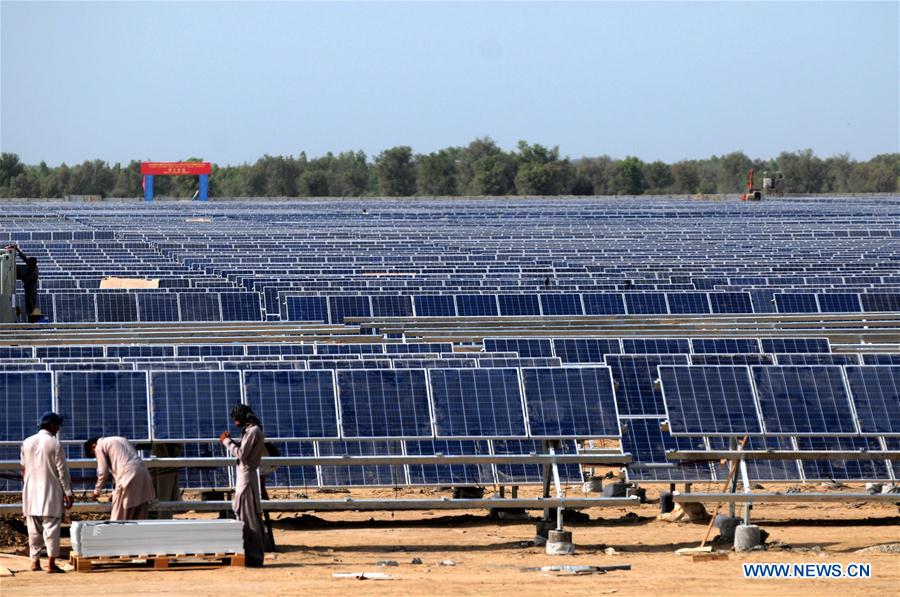Decarbonization and development: China's latest climate commitment embodies its green development strategy

Aerial photo taken on Aug. 19, 2020 shows wind turbines in Jiucaiping scenic spot in southwest China's Guizhou Province. (Xinhua/Liu Xu)
Whenever world leaders gather for the UN General Assembly, all eyes are on China. Uncharacteristically, China topped the headlines among all Western media again by making a major new climate commitment – pledging to stop building coal-burning power plants overseas.
On September 21, Chinese President Xi Jinping announced at the general debate of the 76th session of the United Nations General Assembly that China will step up support for other developing countries in developing green and low-carbon energy, and will not build new coal-fired power projects abroad.
China, always being a practitioner of green development, is making greater and faster strides away from fossil fuels as the country aims to hit peak emissions before 2030 and carbon neutrality by 2060. The announcement, hailed by the international community, is being seen as a significant step in the fight against climate change.
"China's commitment constitutes a huge economic sacrifice as the country has the world's largest thermal power sector, which mostly relies on the overseas market," said Lin Boqiang, dean of the China Institute for Studies in Energy Policy, Xiamen University. "China's willingness to sacrifice its thermal power sector to help developing countries achieve a low-carbon transition displays China's deep determination and swift action in curbing global warming, which other major economies should learn."
A sustainable model for developing countries
Extreme weather, increasing temperatures, and rising sea levels, unprecedented climate change and environmental degradation is a real and pressing threat to the world, which requires that countries take concerted and urgent action. Despite the UN's principle of "common but differentiated responsibilities" when it comes to the climate issue, some Western countries have constantly pressured developing countries to reduce their carbon footprints, forcing them to comprise their economic growth for the sake of protecting the earth's climate.
Developing countries, which often bear the brunt of the climate crisis, heavily rely on fossil fuels to boost their economies as they still remain the cheapest and most reliable energy resources available to them. To solve their plight, it is extremely crucial to figure out how to decouple economic growth from energy consumption.
"Western countries cannot provide any useful tips for developing countries on this question as they were never confronted with such a dilemma," said Lin. "Developed countries have achieved their economic development by burning fossil fuels and emitting greenhouse gases without limits in the past. Now, their stable economic growth and high level of income per capita can enable their economy to remain largely unscathed when developed countries begin prioritizing drastic environmental policies."
Compared with Westerners' empty slogans, China's latest commitment, which strikes a balance between decarbonization and development offers the silver bullet for other developing countries. "President Xi has offered a win-win approach, putting countries on the path to balanced, inclusive, green growth (BIGG) to harmonize people, planet and prosperity," Mohan Munasinghe told People's Daily Online, who served as the former Vice-Chair of the UN Intergovernmental Panel on Climate Change that shared the 2007 Nobel Prize for Peace.

Photo taken on June 17, 2021, shows part of the Qinghai-Henan UHV DC power transmission line in Henan Mongolian Autonomous County of Huangnan Tibetan Autonomous Prefecture, northwest China's Qinghai Province. (Photo by Xie Lirong/Xinhua)
China's commitment will ensure access to affordable, reliable, sustainable and modern energy for developing countries, which can help combat climate change and its impacts, Munasinghe noted. In the long run, it will build resilient infrastructure, promote inclusive and sustainable industrialization and foster innovation in developing countries.
This commitment embodies China's sustainable green development strategy, which has already turned out to be successful domestically. China is going full throttle to develop low-carbon energy and increase its proportion in primary energy consumption nationwide to lighten the burden on the environment and ecosystem. A report on national renewable energy power development released by the National Energy Administration revealed that nearly half of China's installed power generation capacity came from renewable resources, supporting nearly one-third of the country's electricity consumption. Non-fossil energy accounted for 15.9 percent of China's primary energy consumption in 2020. Moreover, the intensity of carbon emissions was reduced by 48.4 percent during the period from 2005 to 2020.
"China's successful low-carbon transition provides valuable references for developing countries wanting to seek alternative paths for environmental protection," said Zhou Dadi, a researcher at the Energy Research Institute of the National Development and Reform Commission.
As the world's largest producer and consumer of renewable energy, China could help develop clean energy in other countries and at the lowest cost, which would "make a qualitative leap in their energy systems."
Greening the Belt and Road Initiative
The announcement will help to green the Belt and Road Initiative (BRI), which takes aim at building a closer partnership for green development and calls for strengthening cooperation in the areas of green infrastructure, green energy, and green finance. To make green a defining feature of Belt and Road cooperation, China is sharing its sustainable dividends with other BRI countries.
Despite the malicious Western media's slanderous views on BRI cooperation, China has been actively working toward green and low-carbon energy transitioning in related countries for years by engaging in extensive cooperation in developing renewable energy. A green milestone was reached in 2020 with renewable power having come to make up the bulk of China's BRI energy investments. The Financial Times reported that the total combined share of wind, solar, and hydropower made up 57 percent, or about $11 billion, of China's overall investments into BRI countries as of 2020, up from 38 percent in 2019.

Workers install solar photovoltaic panels for the Zonergy 900 MW Solar Project in Bahawalpur, Pakistan, Aug. 28, 2015. (Xinhua/Ahmad Kamal)
Cooperation on clean energy projects within the framework of the BRI has been mushrooming. In 2019, the Mozura Wind Park in southern Montenegro, constructed by a consortium of the Shanghai Electric Power Company (SEP) and Maltese state energy provider Enemalta was inaugurated, which now provides more than 112 million kilowatt-hours for the local people and reduces greenhouse gas emissions by 95,000 tons.
"The wind park shows that further green-energy based development is achievable, it adds additional optimism that the country's domestic energy production will continue to meet demand, along with decreasing carbon emissions," said Dragica Sekulic, Montenegro's Minister of Economy, while attending the inauguration event.
Other green cooperation projects, such as the first phase of the solar PV power project in the Quaid-e-Azam Solar Park in Pakistan, the Kaleta hydropower project in Guinea, the Kapsvar PV power station in Hungary, and the Karot hydropower project in Pakistan are also contributing to an accelerated shift away from fossil fuels.
"China's commitment to make the BRI a green cause advancing sustainable development is admirable and far-sighted," said Lin. "It would stabilize developing countries' power supply and help them better harness its rich renewable energy resources."
"The announcement signaled that China would ramp up pushing forward pragmatic and mutually beneficial energy cooperation, building a silk road with green energy," said Yao Shumei, a researcher at the China Academy of Macroeconomic Research under the National Development and Reform Commission. She predicts that China will take a raft of measures moving forward, such as increasing technological, financial, and capacity support for green development in developing countries. China will call on the international community to pay greater attention to the concerns and appeals of developing countries, helping them achieve a green and low-carbon transformation.
For developing countries, China's latest commitment is a source of encouragement. "President Xi's speech at UNGA 2021 provided the much-needed leadership, hope and inspiration that developing countries are looking for," said Munasinghe.
Kou Jie, Meng Bin, and Xia Peiyao contributed to this article.
Photos
Related Stories
Copyright © 2021 People's Daily Online. All Rights Reserved.










